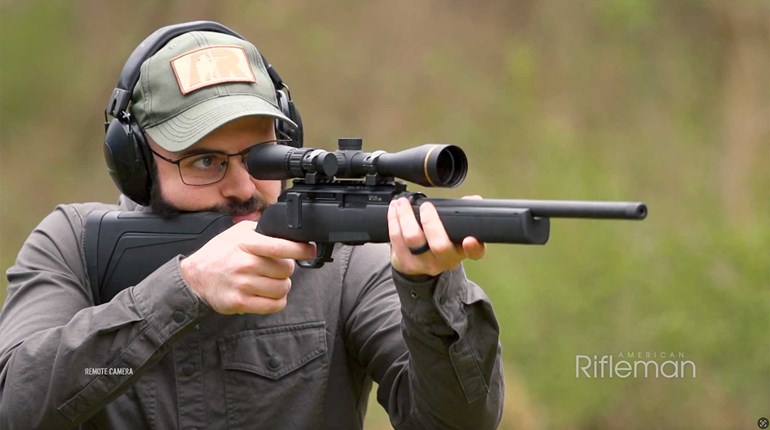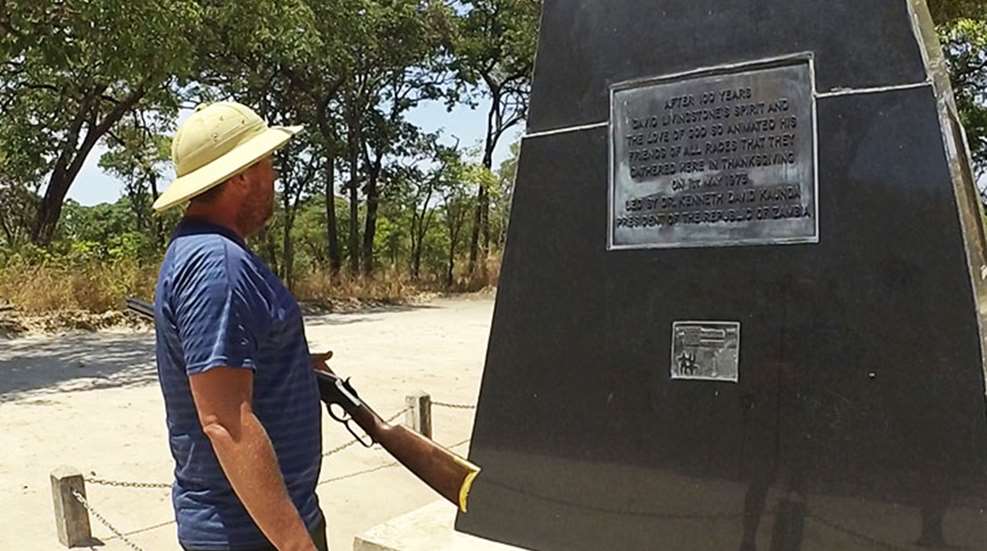
The title for this article came off the bumper of a lorry (commercial truck) driving down a sealed road in Zambia. Painted on that bumper were the words "when the hunting was bad." Sadly, those five short words sum up the Henry Rifle Africa Project (HRAP). After long conversations with Andy Wickstom, the General Manager of Henry Repeating Arms, the plan—to put a Henry Brass lever-action rifle chambered in .45-70 Government into southern Africa for the purpose of hunting medium and large game—was set in motion.
Pete Swanepoel is a professional hunter (PH) and one of the owners of Safaribwana, a hunting and guiding operation based in Zambia. I found him online while looking for information from someone who had hunted in Africa with rifles chambered in .45-70. I discovered that he lives near Denver, Colo., with his family and travels to Zambia to guide hunts.
At first, our phone conversations were about his past success hunting with the .45-70 cartridge in Africa, but that slowly moved on to the idea of PH Swanepoel taking a Henry Brass .45-70 lever-action rifle with him to Zambia on his next hunt. Mr. Wickstrom at Henry rifles agreed to provide the Henry, and HRAP was born.

If you do some quick research on the ballistics of the original .45-70 Government cartridge that the U.S. military introduced in 1873, you’ll not be very impressed, especially if you plan on using it to hunt big game. Your potential survivability factor if you’re hunting Cape buffalo or hippopotamus and only wound one of those very dangerous animals, would be questionable. The original Springfield trapdoor single-shot rifles could not take the pressure of some of the modern .45-70 ammo on today's market.
The Henry Repeating Arms Brass lever-action rifle can handle the much higher pressures of the new and improved .45-70 ammo. Tim Sundles of Buffalo Bore Ammunition signed on board from the very beginning days of HRAP and provided .45/70 ammo in various bullet weights and ballistic capabilities, including some of his .45-70 Magnum ammunition. To ensure Henry Brass .45-70 (Model H010B) that was headed to Zambia was in top-performing, hunting readiness, PH Swanepoel test fired the rifle. Topping the rifle with peep sights from Skinner Sights, Swanepoel noted the positive functionality and accuracy of the Buffalo Bore ammo from the rifle—the combination was established.
For some history, the first original 1860 Henry Repeating Arms lever-action rifle was chambered in .44 rimfire, and was used very successfully during the Civil War. I contacted the National Park Service (NPS) at the Shiloh National Military Park to ascertain whether Henry rifles were present on April 5 and 6, 1862, when the Battle of Shiloh was fought. A lengthy e-mail describing the research they did to answer my question was provided with a negative response about Henry rifles being issued to troops and being used by Union or Confederate units during that battle. Though, the NPS couldn’t rule out the use in combat at Shiloh by private owners of Henry 1860 lever-action rifles.
The reason for questioning whether the Henry rifle was used at the Shiloh battlefield was because the 6th Arkansas Infantry Regiment of the Confederate States of America fought in that two-day battle. Young Private William H. Stanley, late of the country of Wales and the city of New Orleans, La., saw combat those two days, fighting for the 6th Arkansas with his smooth-bore flintlock musket. He would have had to work hard to average three rounds of fire per minute while the Union troops were trying to kill him. Stanley was later to be known as Sir Henry Morton Stanley, knighted for his service to the British Empire in Africa. A lever-action rifle that used self-contained metal cartridges and fired sixteen times before you need to reload would have been a major advantage to Private Stanley at the Battle of Shiloh. The slowness to return fire may have played a role in why Private Stanley was captured at Shiloh and became a prisoner of war, confined in a Union POW camp.
Private Stanley agreed to join the Union Army as a "Galvanized Yankee" but deserted his unit in West Virginia. He traveled back to Wales for a disastrous family reunion, then returned to the U.S. and joined the Union Navy. After a short service in the Union Navy, he deserted and jumped ship for adventures as a journalist in the West. Private Stanley is perhaps the only person that volunteered to serve in the Confederate Army, the Union Army and the Union Navy, without successfully completing any of his agreed upon enlistments.
In 1871, working as a newspaper reporter for the New York Herald, Henry Morton Stanley set out for southern Africa to find the internationally known, but long missing, Scottish physician, missionary and explorer Dr. David Livingstone.
Upon finding Dr. Livingstone on November 10, 1871 in what is today Tanzania, Stanley is alleged to have made the now famous statement "Doctor Livingstone, I presume?" Having had real-life combat experience and betting his life on the use of muzzleloading single-shot rifles, Stanley acquired a 1860 Henry lever-action rifle as one of the firearms he took to Africa. Despite his efforts, he could not persuade Dr. Livingstone to leave Africa with him and return to England. Prior to departing, Stanley tried to leave Dr. Livingston, who had not much more than the clothes on his back when he found him, with as much supplies as he could from the items he brought with him. His 1860 Henry rifle and 1,500 rounds of .44 caliber ammunition were reportedly among the items left with Dr. Livingston, but it has since been lost to history.
Henry Repeating Arms manufactures a current production of the 1860 Henry Rifle. It is known as the New Original Henry, and was first chambered in .44-40. Henry Repeating Arms is now producing their New Original Henry in .45 Colt, and the action manufactured with modern metals can handle .45 Colt +P ammunition.
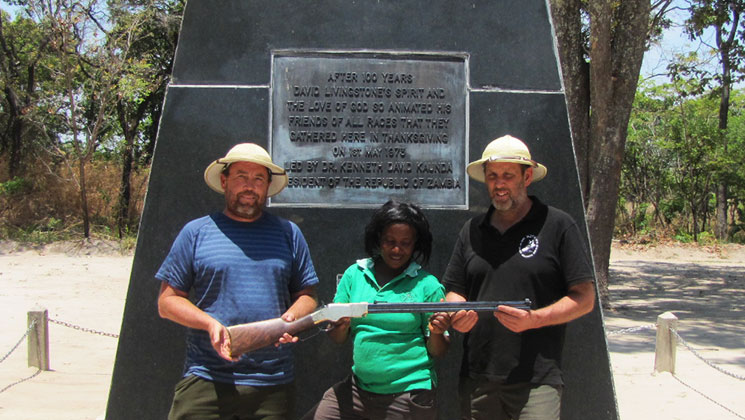
When I really started to put the pieces of the Livingstone connection and Henry rifles together, I made a call to Mr. Anthony Imperato, president and owner of Henry Repeating Arms, with the idea of replicating Stanley’s rifle in hopes of adding it to my existing .45-70 HRAP project. The idea was that PH Swanepool could hunt with both rifles, and prior to departing, would donate the New Original Henry Original rifle to the Livingstone Museum, located in the town of Livingstone, Zambia. Mr. Imperato not only agreed to build the rifle, but built a one-of-a-kind collectible piece in .45 Colt (Model H011C), produced with the serial number HMS1871DRDL. The “HMS” in the serial number is for “Henry Morton Stanley,” followed by the numbers 1871, the year when Henry Morton Stanly found Dr. David Livingstone in Tanzania. The rifle is known as the Livingstone-Henry rifle.
The issues associated with the aforementioned phrase "when the hunting was bad," started upon entering Zambia at the Zambian customs. In October 2017, after making official arrangements to donate the Livingstone-Henry rifle to the Zambian State-owned museum, Swanepoel was confronted with a $2,800 import duty if the rifle was to stay in the country when he left to go back to Colorado. There was a suggestion that if he turned the Livingstone-Henry rifle over to the custom officers, they would see that the rifle got forwarded on to the Livingstone Museum, but once out of Swanepoel's hands, there was very little assurance that the Livingstone-Henry rifle would ever see the light of day again. With no other options, Swanepoel was forced to import both rifles on a temporary hunting permits, which unfortunately required the two rifles to leave the country when Swanepoel departed.
Still set on hunting with the rifles, Swanepoel took the Henry-Livingston rifle to the site where Dr. Livingstone died and his heart was first buried before it was removed and returned to England. The plan was for a photo-op at the memorial site prior to some hunting with the rifle. With photos complete, Swanepoel moved his hunting safari northeast to the Mpika area in the Muchinga Mountains and to 30,000 acres of land that Safaribwana had acquired. This was land that had been previously set aside for a railroad, and supposedly there had been no legal hunting on the property for years.
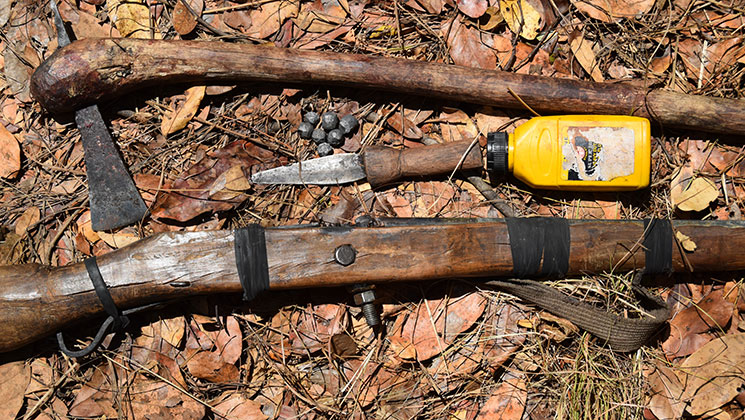
Upon arrival, it became apparent that game was scarce; poaching had run rampant. Shortly after setting up their base camp, the gunshots started. Poachers who had been too long unchecked by game enforcement laws were in Swanepoel's very presence, killing anything that moved, to smoke on camp fires as bush meat. A game animal that might cost a foreign hunter $1,000 in licensing fees was being shot with a homemade muzzleloading rifle, smoked in unsanitary conditions and then rushed out to the local community roads and sold for pennies on the dollar as bush meat to pedestrians walking by.
The trees on the Safaribwana land were being illegally cut down and turned into charcoal. When the poachers realized Swanepoel and his crew—which included game enforcement officers—were present in the area, they started bush fires in an attempt to destroy Swanepoel’s base camp and scare the group off. Instead, Swanepoel used his own vehicles, fuel and man-hours to assist the game rangers in transporting captured poachers and driving them back to law enforcement incarceration facilities.
There was little to hunt, so when the truck with "when the hunting was bad" on the painted bumper went by their vehicles at the end of the trip, it was apropos. Sadly, even though the right people, the right Henry rifles and the right ammunition went to Zambia to have a positive effect on both past history and the future—through the financial benefits of legal hunting—poaching and importation issues turned a great idea into a complete failure, and both the past and future suffered.
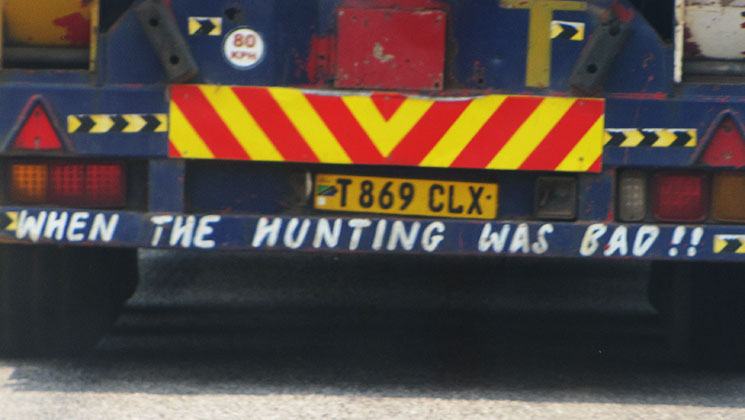
This is not the end of the story, but it is the end of a sad chapter. In October 2018, Swanepoel plans to return to Zambia and will once again attempt to hunt with both rifles and deliver the Livingstone-Henry rifle to the Livingstone Museum. There will be other efforts to get control of the poaching of under-valued game. In the meantime, there is still a loss and the question is how large will that loss be.
For now, we simply must deal with "when the hunting was bad."












